Mårten Björkman
Domain Randomization for Object Detection in Manufacturing Applications using Synthetic Data: A Comprehensive Study
Jun 09, 2025Abstract:This paper addresses key aspects of domain randomization in generating synthetic data for manufacturing object detection applications. To this end, we present a comprehensive data generation pipeline that reflects different factors: object characteristics, background, illumination, camera settings, and post-processing. We also introduce the Synthetic Industrial Parts Object Detection dataset (SIP15-OD) consisting of 15 objects from three industrial use cases under varying environments as a test bed for the study, while also employing an industrial dataset publicly available for robotic applications. In our experiments, we present more abundant results and insights into the feasibility as well as challenges of sim-to-real object detection. In particular, we identified material properties, rendering methods, post-processing, and distractors as important factors. Our method, leveraging these, achieves top performance on the public dataset with Yolov8 models trained exclusively on synthetic data; mAP@50 scores of 96.4% for the robotics dataset, and 94.1%, 99.5%, and 95.3% across three of the SIP15-OD use cases, respectively. The results showcase the effectiveness of the proposed domain randomization, potentially covering the distribution close to real data for the applications.
DLO-Splatting: Tracking Deformable Linear Objects Using 3D Gaussian Splatting
May 13, 2025Abstract:This work presents DLO-Splatting, an algorithm for estimating the 3D shape of Deformable Linear Objects (DLOs) from multi-view RGB images and gripper state information through prediction-update filtering. The DLO-Splatting algorithm uses a position-based dynamics model with shape smoothness and rigidity dampening corrections to predict the object shape. Optimization with a 3D Gaussian Splatting-based rendering loss iteratively renders and refines the prediction to align it with the visual observations in the update step. Initial experiments demonstrate promising results in a knot tying scenario, which is challenging for existing vision-only methods.
Adapting Robot's Explanation for Failures Based on Observed Human Behavior in Human-Robot Collaboration
Apr 13, 2025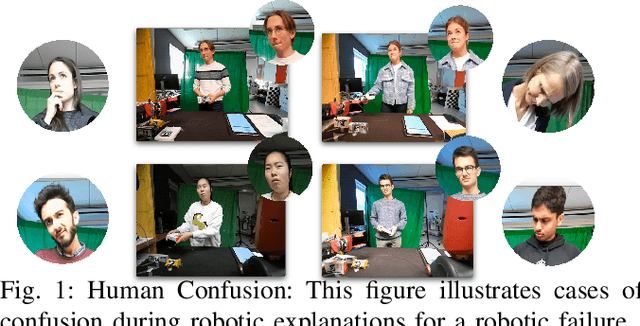
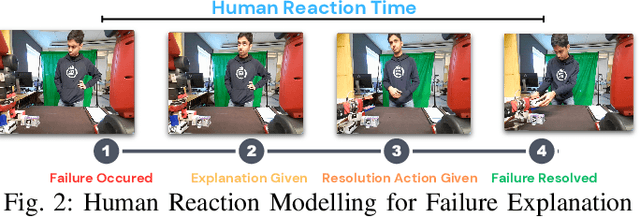
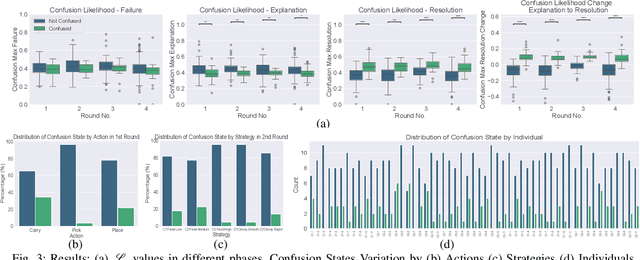
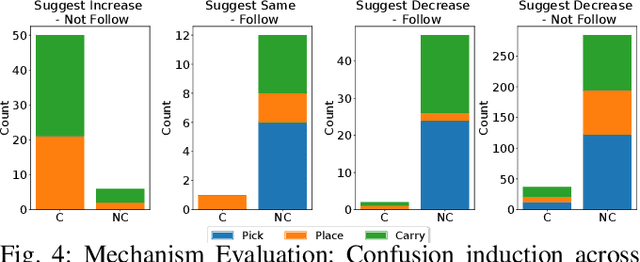
Abstract:This work aims to interpret human behavior to anticipate potential user confusion when a robot provides explanations for failure, allowing the robot to adapt its explanations for more natural and efficient collaboration. Using a dataset that included facial emotion detection, eye gaze estimation, and gestures from 55 participants in a user study, we analyzed how human behavior changed in response to different types of failures and varying explanation levels. Our goal is to assess whether human collaborators are ready to accept less detailed explanations without inducing confusion. We formulate a data-driven predictor to predict human confusion during robot failure explanations. We also propose and evaluate a mechanism, based on the predictor, to adapt the explanation level according to observed human behavior. The promising results from this evaluation indicate the potential of this research in adapting a robot's explanations for failures to enhance the collaborative experience.
Impact of Object Weight in Handovers: Inspiring Robotic Grip Release and Motion from Human Handovers
Feb 25, 2025Abstract:This work explores the effect of object weight on human motion and grip release during handovers to enhance the naturalness, safety, and efficiency of robot-human interactions. We introduce adaptive robotic strategies based on the analysis of human handover behavior with varying object weights. The key contributions of this work includes the development of an adaptive grip-release strategy for robots, a detailed analysis of how object weight influences human motion to guide robotic motion adaptations, and the creation of handover-datasets incorporating various object weights, including the YCB handover dataset. By aligning robotic grip release and motion with human behavior, this work aims to improve robot-human handovers for different weighted objects. We also evaluate these human-inspired adaptive robotic strategies in robot-to-human handovers to assess their effectiveness and performance and demonstrate that they outperform the baseline approaches in terms of naturalness, efficiency, and user perception.
REFLEX Dataset: A Multimodal Dataset of Human Reactions to Robot Failures and Explanations
Feb 20, 2025Abstract:This work presents REFLEX: Robotic Explanations to FaiLures and Human EXpressions, a comprehensive multimodal dataset capturing human reactions to robot failures and subsequent explanations in collaborative settings. It aims to facilitate research into human-robot interaction dynamics, addressing the need to study reactions to both initial failures and explanations, as well as the evolution of these reactions in long-term interactions. By providing rich, annotated data on human responses to different types of failures, explanation levels, and explanation varying strategies, the dataset contributes to the development of more robust, adaptive, and satisfying robotic systems capable of maintaining positive relationships with human collaborators, even during challenges like repeated failures.
Early Detection of Human Handover Intentions in Human-Robot Collaboration: Comparing EEG, Gaze, and Hand Motion
Feb 17, 2025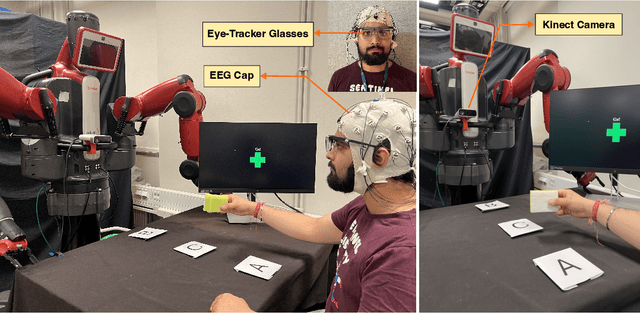
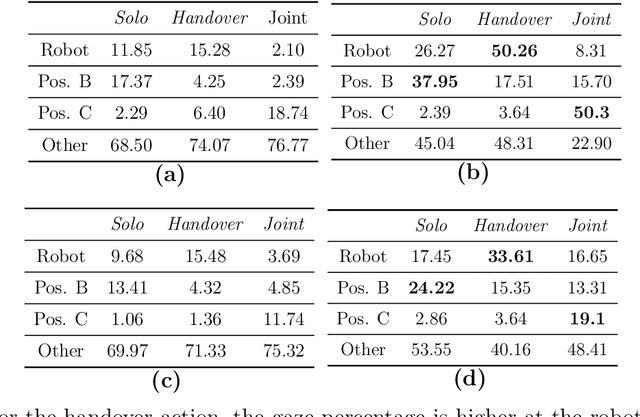
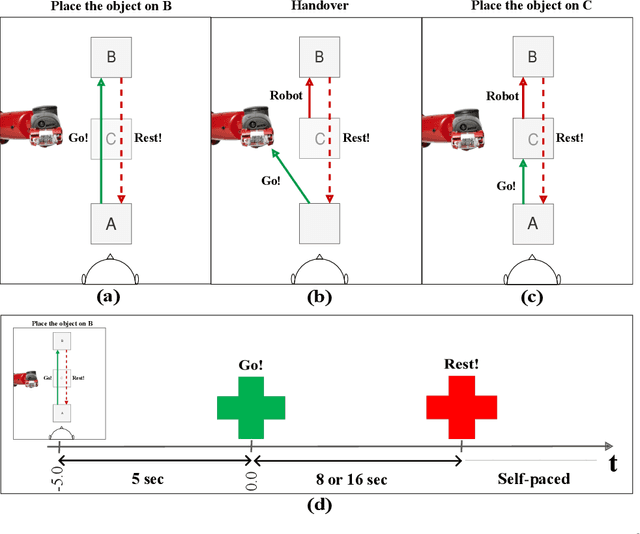

Abstract:Human-robot collaboration (HRC) relies on accurate and timely recognition of human intentions to ensure seamless interactions. Among common HRC tasks, human-to-robot object handovers have been studied extensively for planning the robot's actions during object reception, assuming the human intention for object handover. However, distinguishing handover intentions from other actions has received limited attention. Most research on handovers has focused on visually detecting motion trajectories, which often results in delays or false detections when trajectories overlap. This paper investigates whether human intentions for object handovers are reflected in non-movement-based physiological signals. We conduct a multimodal analysis comparing three data modalities: electroencephalogram (EEG), gaze, and hand-motion signals. Our study aims to distinguish between handover-intended human motions and non-handover motions in an HRC setting, evaluating each modality's performance in predicting and classifying these actions before and after human movement initiation. We develop and evaluate human intention detectors based on these modalities, comparing their accuracy and timing in identifying handover intentions. To the best of our knowledge, this is the first study to systematically develop and test intention detectors across multiple modalities within the same experimental context of human-robot handovers. Our analysis reveals that handover intention can be detected from all three modalities. Nevertheless, gaze signals are the earliest as well as the most accurate to classify the motion as intended for handover or non-handover.
Human-Aligned Image Models Improve Visual Decoding from the Brain
Feb 05, 2025Abstract:Decoding visual images from brain activity has significant potential for advancing brain-computer interaction and enhancing the understanding of human perception. Recent approaches align the representation spaces of images and brain activity to enable visual decoding. In this paper, we introduce the use of human-aligned image encoders to map brain signals to images. We hypothesize that these models more effectively capture perceptual attributes associated with the rapid visual stimuli presentations commonly used in visual brain data recording experiments. Our empirical results support this hypothesis, demonstrating that this simple modification improves image retrieval accuracy by up to 21% compared to state-of-the-art methods. Comprehensive experiments confirm consistent performance improvements across diverse EEG architectures, image encoders, alignment methods, participants, and brain imaging modalities.
How do Humans take an Object from a Robot: Behavior changes observed in a User Study
Jan 03, 2025


Abstract:To facilitate human-robot interaction and gain human trust, a robot should recognize and adapt to changes in human behavior. This work documents different human behaviors observed while taking objects from an interactive robot in an experimental study, categorized across two dimensions: pull force applied and handedness. We also present the changes observed in human behavior upon repeated interaction with the robot to take various objects.
Cloth-Splatting: 3D Cloth State Estimation from RGB Supervision
Jan 03, 2025



Abstract:We introduce Cloth-Splatting, a method for estimating 3D states of cloth from RGB images through a prediction-update framework. Cloth-Splatting leverages an action-conditioned dynamics model for predicting future states and uses 3D Gaussian Splatting to update the predicted states. Our key insight is that coupling a 3D mesh-based representation with Gaussian Splatting allows us to define a differentiable map between the cloth state space and the image space. This enables the use of gradient-based optimization techniques to refine inaccurate state estimates using only RGB supervision. Our experiments demonstrate that Cloth-Splatting not only improves state estimation accuracy over current baselines but also reduces convergence time.
Can Transformers Smell Like Humans?
Nov 05, 2024
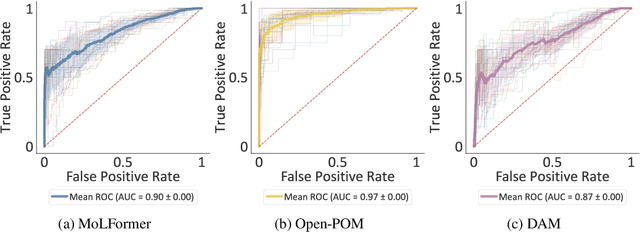
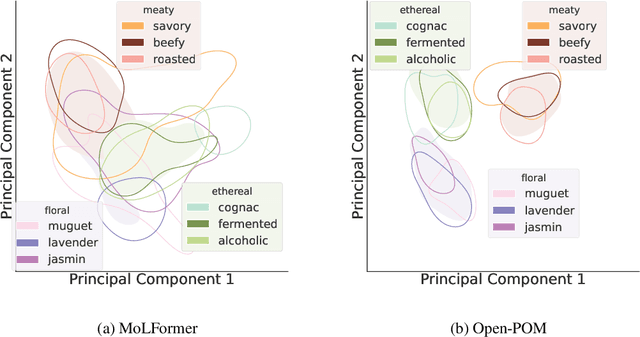
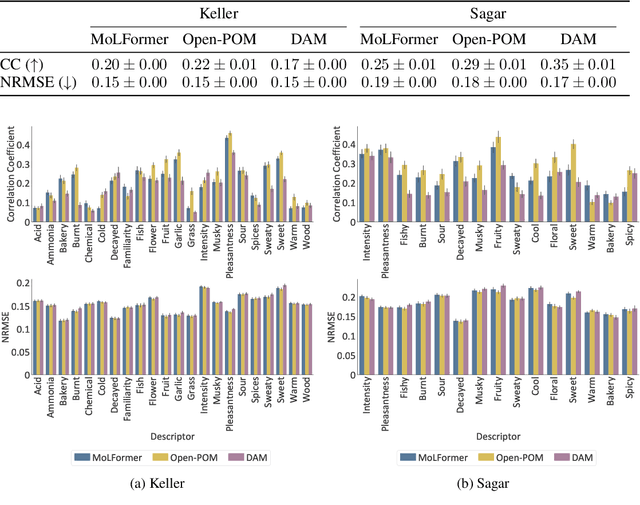
Abstract:The human brain encodes stimuli from the environment into representations that form a sensory perception of the world. Despite recent advances in understanding visual and auditory perception, olfactory perception remains an under-explored topic in the machine learning community due to the lack of large-scale datasets annotated with labels of human olfactory perception. In this work, we ask the question of whether pre-trained transformer models of chemical structures encode representations that are aligned with human olfactory perception, i.e., can transformers smell like humans? We demonstrate that representations encoded from transformers pre-trained on general chemical structures are highly aligned with human olfactory perception. We use multiple datasets and different types of perceptual representations to show that the representations encoded by transformer models are able to predict: (i) labels associated with odorants provided by experts; (ii) continuous ratings provided by human participants with respect to pre-defined descriptors; and (iii) similarity ratings between odorants provided by human participants. Finally, we evaluate the extent to which this alignment is associated with physicochemical features of odorants known to be relevant for olfactory decoding.
 Add to Chrome
Add to Chrome Add to Firefox
Add to Firefox Add to Edge
Add to Edge